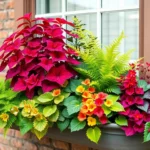Your kitchen window holds untapped potential for creating a thriving indoor garden that’s both beautiful and functional. We’ve discovered that the right plants can transform this space into a vibrant focal point while providing fresh herbs and greenery at your fingertips.
Kitchen windows offer unique advantages for plant growing – they typically receive consistent natural light and benefit from the humidity created by cooking activities. Whether you’re working with a spacious bay window or a compact sill, there’s a perfect plant combination waiting to flourish in your culinary space.
We’ll explore creative ideas that maximize your window’s potential, from cascading herb gardens that make meal prep effortless to stunning displays of flowering plants that brighten your daily routine. These carefully selected options thrive in kitchen environments and require minimal maintenance, making them perfect for busy home cooks who want to bring nature indoors.
Best Low-Light Kitchen Window Plants for Busy Cooks
Many kitchen windows don’t receive bright sunlight throughout the day, but that doesn’t mean you can’t enjoy thriving greenery. We’ve identified the most resilient plants that flourish in dim conditions while requiring minimal care from busy home cooks.
Snake Plants for Minimal Maintenance
Snake plants (Sansevieria trifasciata) top our list for extremely low light kitchen windows because they thrive in virtually any lighting condition. These architectural beauties can go weeks without water, making them perfect for cooks who travel frequently or maintain hectic schedules.
Watering frequency: Every 2-3 weeks during growing season, monthly in winter
Light requirements: Tolerates low to bright indirect light
Growth pattern: Upright, space-saving design ideal for narrow windowsills
We recommend placing snake plants in small to medium ceramic pots that complement your kitchen’s color scheme. Their thick, sword-like leaves add modern elegance while purifying air naturally through their unique nighttime oxygen production.
ZZ Plants for Dark Corner Windows
ZZ plants (Zamioculcas zamiifolia) excel in the darkest kitchen corners where other plants typically struggle or fail completely. These glossy-leaved champions store water in their thick stems and roots, creating an almost foolproof option for busy households.
Survival rate: 95% success rate in low light conditions
Watering needs: Every 2-4 weeks depending on season
Temperature tolerance: 65-75°F (ideal kitchen range)
Place ZZ plants near north-facing windows or in corners that receive minimal natural light throughout the day. Their waxy leaves reflect available light beautifully, creating visual interest even in dimmer kitchen spaces while requiring almost zero daily attention.
Pothos Varieties for Hanging Displays
Pothos plants offer versatile hanging answers for kitchen windows with limited natural light, trailing gracefully from elevated positions. We particularly love golden pothos and marble queen varieties because they adapt quickly to low light conditions while creating stunning cascading displays.
Popular varieties for kitchens:
- Golden pothos: Yellow and green variegated leaves
- Marble queen: White and green marbled pattern
- Jade pothos: Deep green, fastest growing variety
Mount hanging planters 2-3 feet from your kitchen window to maximize available light while keeping trailing vines away from cooking surfaces. These hardy plants propagate easily in water, allowing you to expand your kitchen garden collection without additional plant purchases.
Herb Garden Window Ideas to Enhance Your Cooking

Building on the foundational plants we’ve discussed, let’s explore how to transform your kitchen window into a functional herb garden that’ll revolutionize your daily cooking routine.
Essential Culinary Herbs for Year-Round Growing
Basil varieties top our list of must-have kitchen herbs, thriving in sunny windows while providing fresh leaves for pasta, pizza, and pesto. Chives offer year-round harvesting potential with their onion-like flavor, perfect for scrambled eggs, soups, and salads. Cilantro grows quickly in cooler spots and adds fresh brightness to Mexican, Asian, and Mediterranean dishes.
Parsley serves dual purposes as both a garnish and flavor enhancer, growing continuously when harvested properly. Oregano brings Mediterranean flair to your cooking, while thyme offers earthy notes that complement roasted vegetables and meat dishes. Rosemary thrives in sunny windows and provides aromatic needles for bread, potatoes, and grilled dishes.
Sage grows well indoors and pairs beautifully with pasta and poultry dishes. Mint spreads easily in containers, making it perfect for teas, cocktails, and Middle Eastern cuisine. Dill completes our essential collection with its distinctive flavor for fish, pickles, and Scandinavian dishes.
| Herb | Root Depth Needed | Light Requirements | Harvest Frequency |
|---|---|---|---|
| Basil | 6 inches | Full sun | Weekly |
| Chives | 6 inches | Partial sun | Every 2-3 days |
| Cilantro | 12 inches | Partial sun | Bi-weekly |
| Parsley | 8 inches | Partial sun | Weekly |
| Mint | 6 inches | Partial shade | Every 3-4 days |
Creative Herb Planting Containers and Arrangements
Terracotta pots create the classic herb garden look while providing excellent drainage for healthy root systems. Mason jars bring rustic charm to your window sill and work perfectly for herbs with shallow root systems like chives and mint. Magnetic containers attach directly to your refrigerator, maximizing space in smaller kitchens while keeping herbs within easy reach.
Hanging baskets transform your window into a cascading green display, perfect for trailing herbs like oregano and thyme. Vertical wall planters create living walls when floor space becomes limited, accommodating multiple herb varieties in a compact footprint. Window sill planters span the entire length of your window, creating a continuous herb border that maximizes growing space.
Ceramic pots offer decorative options that complement your kitchen’s aesthetic while providing durability for long-term growing. Repurposed containers like old coffee cans or yogurt containers work effectively for budget-conscious gardeners when proper drainage holes are added.
Tips for Harvesting Fresh Herbs Daily
Morning harvesting captures herbs when their essential oils are most concentrated, typically between 8-10 AM for maximum flavor intensity. Top-down cutting encourages bushier growth patterns by snipping leaves from the upper portions of each plant. One-third rule maintains plant health by never harvesting more than one-third of the plant at any single time.
Frequent pinching promotes continuous growth and prevents herbs from flowering too early, which can make leaves bitter. Sharp scissors or pruning shears create clean cuts that heal quickly and reduce stress on your plants. Regular harvesting actually encourages more vigorous growth, giving you a steady supply of fresh herbs for daily cooking needs.
Proper storage extends your harvest by placing cut herbs in water like fresh flowers or wrapping them in damp paper towels before refrigerating. Immediate use provides the best flavor impact, so we recommend harvesting just before adding herbs to your dishes whenever possible.
Stylish Succulent Window Displays That Thrive in Kitchen Heat

Succulents transform kitchen windowsills into vibrant mini-ecosystems that brighten the space with diverse shapes and colors while requiring minimal care. Their water-storing abilities make them perfectly suited to fluctuating kitchen temperatures from cooking heat and direct sunlight exposure.
Heat-Tolerant Succulent Varieties
Hens and chicks (Sempervivum) top our list of heat-tolerant kitchen succulents due to their exceptional ability to withstand warm conditions and bright light. These rosette-shaped plants multiply naturally, creating stunning clustered displays that thrive near sunny windows.
Echeveria varieties offer beautiful pastel colors ranging from blue-green to pink and purple, making them perfect statement pieces for modern kitchen aesthetics. Their thick, fleshy leaves store water efficiently, allowing them to handle the dry conditions commonly found near kitchen windows.
Jade plants serve as excellent long-term kitchen companions, growing slowly into tree-like specimens that can last for decades with minimal care. We’ve found they particularly enjoy the consistent warmth from cooking activities and bright morning light.
Aloe vera provides both beauty and functionality, offering soothing gel for minor kitchen burns while thriving in the warm, bright conditions typical of kitchen environments. This dual-purpose succulent requires little water and tolerates the sometimes dry air near cooking areas.
Modern Geometric Planters and Arrangements
Hexagonal ceramic pots create striking contemporary displays when arranged in clusters of varying sizes across your kitchen windowsill. These angular planters enhance the minimalist aesthetic that makes succulent collections so appealing in modern kitchen designs.
Triangular terrariums maximize vertical space while providing an architectural touch that complements sleek kitchen fixtures. Clear glass containers allow you to appreciate both the plants and their root systems, creating educational displays for curious family members.
Stacked planters use vertical space efficiently, particularly beneficial for narrow kitchen windowsills where horizontal space is limited. We recommend arranging different succulent varieties at various heights to create visual depth and interest.
Cluster arrangements of varied sizes and shapes within geometric planters create chic, contemporary looks that serve as living art pieces. Combining 3-5 different succulent types in complementary planters establishes focal points that draw the eye naturally.
Watering Schedules for Kitchen Succulents
Every 1-2 weeks represents the ideal watering frequency for most kitchen succulents, though you should always check soil dryness before adding water. The key is waiting until the soil feels completely dry to the touch, as succulents prefer drought conditions over moisture.
Pea gravel drainage at the bottom of containers prevents root rot, which poses the biggest threat to succulent health in kitchen environments. We place a half-inch layer of small rocks or pebbles before adding potting soil to ensure proper water flow.
Minimal water application works best for container succulents without drainage holes, requiring just a few drops occasionally rather than thorough soaking. Kitchen humidity and ambient moisture from cooking activities often provide additional hydration these drought-adapted plants need.
Soil dryness testing involves inserting your finger about an inch into the soil to check moisture levels before watering. This simple technique prevents overwatering, which kills more succulents than underwatering ever could.
Flowering Plants to Add Color and Fragrance to Your Kitchen Window

Moving beyond herbs and succulents, we’ll explore flowering plants that transform your kitchen window into a vibrant display of color and natural fragrance.
African Violets for Continuous Blooms
African violets deliver year-round flowering performance that makes your kitchen window a constant source of beauty. These compact plants thrive in the bright, indirect light that most kitchen windows provide while producing continuous blooms with minimal care requirements. We love their vibrant flowers that come in various shades of purple, pink, and white, creating lasting color throughout every season.
Watering requirements stay simple since African violets prefer well-draining soil that you can maintain with weekly watering sessions. Their soft fragrance enhances your kitchen atmosphere without overwhelming other cooking aromas. Care routines involve removing spent blooms and rotating the plant weekly for even growth patterns.
Begonias for Bright Kitchen Accents
Begonias create striking visual impact through their colorful flowers and attractive foliage combinations. These versatile plants flourish in bright but indirect light conditions while handling the variable humidity levels that kitchens naturally provide. We recommend begonias for their ability to bring bright accents in reds, oranges, and pinks that make any kitchen feel more lively and inviting.
Temperature tolerance helps begonias adapt to cooking heat fluctuations better than many flowering alternatives. Their blooming cycles extend for months when you provide consistent moisture and occasional feeding. Maintenance involves deadheading spent flowers and monitoring soil moisture levels to prevent root rot.
Seasonal Flowering Options
Seasonal flowering plants offer ever-changing variety that keeps your kitchen window garden fresh and visually appealing throughout the year. We suggest rotating chrysanthemums, jasmine, and gloxinia to provide vivid flowers and pleasant scents during their respective growing seasons. This approach allows you to enjoy different fragrances and color combinations as seasons change.
Chrysanthemums bring autumn warmth with their rich yellows, oranges, and deep reds during fall months. Jasmine varieties provide intense fragrance that fills your kitchen with sweet scents during their blooming periods. Gloxinia plants offer dramatic trumpet-shaped flowers in bold purples and pinks that create stunning focal points during summer seasons.
Switching seasonal plants prevents monotony while ensuring continuous flowering displays. Storage answers for dormant plants include cool, dark spaces where you can maintain minimal watering schedules until their next growing season arrives.
Creative Vertical Garden Ideas for Small Kitchen Windows

Vertical gardening maximizes limited space by growing plants upward instead of outward, making it perfect for small kitchen windows. This approach adds greenery and utility without cluttering countertops or window sills.
Wall-Mounted Planter Systems
Wall-mounted planter boxes transform your kitchen window area into a productive growing space. We recommend installing these planters directly on or near the window wall using materials like wood, metal, or repurposed items such as wooden crates and painted cans for a personalized touch.
Slat walls offer modular flexibility for your vertical garden setup. Wooden panels enable easy attachment of multiple planters, creating a customizable display perfect for herbs, small vegetables, or flowers. This system allows you to rearrange plants as they grow and change with the seasons.
Magnetic planters stick directly to metal surfaces near your window. These innovative containers work exceptionally well on refrigerator sides or metal backsplashes, keeping herbs within arm’s reach while cooking.
Tiered Shelving Answers
Multi-tiered container gardens create layers using shelving structures or stacked containers of different sizes. Place larger containers on the bottom and smaller ones on top, which works perfectly for kitchen herbs or compact vegetables like cherry tomatoes and peppers.
Repurposed wooden ladders serve as charming vertical plant stands. Add hooks or shelves to each rung, then lean the ladder against a wall or mount it near your kitchen window. This dual-purpose solution functions as both shelf and trellis for climbing plants like green beans or small cucumbers.
Stackable modular planters offer professional-looking vertical gardens. These systems typically include built-in drainage and can accommodate various plant sizes, from leafy herbs to compact vegetables that need sturdy support systems.
Hanging Garden Arrangements
Hanging baskets suspended by ropes or chains create a floating garden effect above your kitchen window. Rectangular or round baskets hold various herbs or trailing plants like pothos, adding greenery without consuming surface space.
Textile organizers with pockets provide unconventional but effective vertical gardening answers. Hanging shoe storage bags work surprisingly well for small herb gardens, with each pocket holding individual plants like basil, thyme, parsley, and mint.
Macrame plant hangers add bohemian style to your kitchen window garden. These rope or cord holders suspend pots at different heights, creating visual interest while keeping plants accessible for daily harvesting and care.
Easy-Care Air-Purifying Plants for Healthier Kitchen Environments

Beyond the visual appeal of herbs and succulents, we can enhance our kitchen’s air quality with plants that actively filter toxins while requiring minimal maintenance. These air-purifying varieties create healthier cooking environments by removing harmful pollutants and regulating humidity levels.
Spider Plants for Natural Air Filtration
Spider plants excel at removing formaldehyde and carbon monoxide from kitchen air, making them perfect companions for gas stoves and cooking areas. These resilient plants produce charming “spiderettes” or baby plants that cascade gracefully from the mother plant, creating an attractive waterfall effect on windowsills.
Propagation becomes effortless since these spiderettes root easily in water or soil, giving us endless plants to expand our kitchen garden or share with friends. Watering requirements stay minimal as spider plants thrive when we allow the soil to partially dry between waterings.
Bright indirect light suits them perfectly, which most kitchen windows provide naturally. Pet safety remains a priority since spider plants pose no toxicity concerns for curious cats or dogs exploring the windowsill area.
Peace Lilies for Humidity Control
Peace lilies remove multiple toxins including formaldehyde, benzene, and carbon monoxide while adding elegant white blooms to our kitchen windows. These plants naturally regulate indoor humidity levels, which proves especially beneficial in kitchens where cooking creates moisture fluctuations.
Growing height reaches approximately 16 inches, making peace lilies ideal for small to medium kitchen windows without overwhelming the space. Indirect sunlight satisfies their lighting needs even in north-facing kitchen windows where direct sun exposure stays limited.
Regular watering maintains their lush appearance and encourages the distinctive white blooms that signal healthy air purification activity. Low maintenance care involves simply monitoring soil moisture and providing consistent watering schedules.
Rubber Trees for Large Window Spaces
Rubber trees filter airborne toxins effectively while their substantial foliage creates a bold green statement in spacious kitchen windows. These plants require more room than smaller varieties but reward us with impressive air cleaning capabilities and striking visual impact.
Large leaves contribute to moisture balance in kitchen environments where cooking activities create varying humidity levels throughout the day. Moderate watering schedules keep rubber trees healthy without creating waterlogged soil conditions.
Indirect light exposure works best for maintaining their glossy leaf appearance and preventing scorching from direct afternoon sun. Space requirements favor larger windows where these plants can spread their broad leaves without crowding other kitchen window plants or blocking natural light.
Budget-Friendly DIY Planter Ideas and Window Garden Projects

Creating stunning kitchen window gardens doesn’t have to strain your budget. We’ll explore cost-effective DIY answers that transform everyday items into beautiful planters for your culinary space.
Repurposed Container Gardens
Old tins, teacups, and glass jars become charming planters when we give them a second life in our kitchen windows. These repurposed containers add unique character while reducing waste, making them perfect for small windowsill spaces. We can group several mismatched containers together to create an eclectic display that showcases herbs and small plants.
Empty food cans work exceptionally well for this purpose, especially when we remove labels and add drainage holes. Vintage teacups offer delicate charm for smaller herbs like thyme or chives. Glass jars from pickles or sauces provide clear visibility for monitoring soil moisture levels.
Mason Jar Herb Gardens
Mason jars excel as DIY planters due to their perfect size for narrow windowsills and clear glass construction. We can easily monitor soil moisture through the transparent walls, making watering management much simpler. These versatile containers fit perfectly in wooden crates or hang beautifully with simple macramé hangers to maximize vertical space.
Basil, parsley, and thyme thrive particularly well in mason jar environments. We recommend using pint-sized jars for most herbs, though smaller 8-ounce jars work well for compact varieties. Adding small pebbles at the bottom creates proper drainage, ensuring healthy root development.
Wooden Box Planters
Wooden box planters bring rustic charm to kitchen windows while accommodating multiple plants in a single container. We can customize these boxes to fit exact window dimensions, creating efficient use of available space. These planters work beautifully for growing variety gardens that combine herbs, leafy greens, and small succulents.
Scrap wood from previous projects often provides free materials for these planters. We can build them using basic carpentry skills or purchase inexpensive pre-made versions. Cedar and pine offer natural resistance to moisture, though any wood works well when properly sealed. Painting options range from natural wood stains to bright colors that complement kitchen decor.
Seasonal Kitchen Window Plant Rotation Strategies

Rotating your kitchen window plants throughout the year maximizes their health and productivity while matching each season’s unique growing conditions. We’ll guide you through strategic timing and care adjustments that keep your window garden thriving year-round.
Spring Planting Schedules
Spring marks the perfect time to establish leafy greens and cool-weather herbs in your kitchen window garden. We recommend starting with lettuce, spinach, and kale during early spring when temperatures remain moderate and daylight hours steadily increase. These nitrogen-loving plants benefit from the gentle warmth and growing light conditions that spring provides.
Basil and parsley thrive when planted in mid-spring as temperatures stabilize and natural light becomes more abundant. Starting seedlings indoors near your kitchen window takes advantage of increasing daylight while protecting young plants from outdoor temperature fluctuations. We suggest using nitrogen-rich potting soil to support the vigorous foliage growth that spring herbs require.
Cool-season crops like arugula and cilantro perform exceptionally well during spring’s moderate conditions before summer heat arrives. Planning your spring rotation around these temperature-sensitive plants ensures a productive harvest during their optimal growing season.
Summer Heat Management
Summer’s intense sunlight and elevated temperatures require careful plant selection and protective strategies for kitchen window gardens. We recommend transitioning to heat-tolerant varieties like cherry tomatoes, small peppers, and drought-resistant succulents that flourish in warm, sunny conditions.
Managing excessive heat becomes crucial during peak summer months when kitchen windows can reach stressful temperatures. Installing sheer curtains filters harsh afternoon sun while maintaining adequate light levels for plant growth. Opening nearby windows creates beneficial air circulation that prevents heat buildup around your plants.
Moving plants slightly away from direct sun during the hottest part of the day protects them from heat stress without eliminating necessary light exposure. We increase watering frequency during summer since kitchen windows dry out containers more rapidly than other indoor locations. Regular monitoring prevents drought stress while avoiding overwatering in the increased heat.
Winter Care and Light Supplements
Winter presents unique challenges with reduced natural light and cooler temperatures near kitchen windows. We select cold-tolerant herbs like rosemary and thyme that handle lower light conditions and temperature fluctuations better than summer varieties.
Supplemental lighting becomes essential during winter months when natural daylight decreases significantly. Installing grow lights above your kitchen window plants provides the additional brightness needed for healthy growth and prevents the stretching that occurs in low-light conditions. We position LED grow lights 12-18 inches above plants and run them for 12-14 hours daily to compensate for shortened daylight periods.
Maintaining moderate humidity levels helps plants cope with dry indoor air from heating systems. We avoid placing plants directly against cold window glass where temperature drops can damage sensitive foliage. Moving containers a few inches away from the window creates a buffer zone that protects plants from cold drafts while maintaining access to available natural light.
Conclusion
Transforming your kitchen window into a thriving garden doesn’t require extensive gardening experience or a massive budget. We’ve shown you how simple herbs succulents and flowering plants can enhance both your cooking and your space’s aesthetic appeal.
Whether you’re working with limited light abundant sunshine or minimal counter space there’s a perfect plant solution waiting for you. From budget-friendly DIY planters to seasonal rotation strategies these approaches ensure year-round success.
Your kitchen window garden will become more than just decoration—it’ll provide fresh ingredients cleaner air and a daily dose of natural beauty. Start small with one or two plants and watch as your confidence and collection grow together.
Frequently Asked Questions
What are the best low-light plants for kitchen windows?
Snake plants, ZZ plants, and pothos varieties are excellent choices for low-light kitchen windows. These resilient plants thrive in various lighting conditions and require minimal care, making them perfect for busy home cooks. They can tolerate the fluctuating conditions of kitchen environments while adding beautiful greenery to your space.
Which herbs grow best in kitchen window gardens?
Essential culinary herbs like basil, oregano, thyme, rosemary, and parsley are ideal for kitchen window gardens. These herbs thrive in the natural light and humidity of kitchen spaces, providing fresh ingredients year-round. They’re easy to maintain and perfect for busy cooks who want immediate access to fresh herbs while cooking.
How do I create a vertical garden in a small kitchen window?
Use wall-mounted systems, hanging planters, and tiered shelving to maximize vertical space. Install small shelves or rails near your window to hold multiple plants at different heights. This approach allows you to grow more plants in limited space while creating an attractive living wall effect.
What flowering plants work well in kitchen windows?
Choose heat-tolerant flowering plants like African violets, begonias, and small orchids that can handle kitchen temperatures and humidity. These plants add color and fragrance to your kitchen while thriving in the unique environment. Consider rotating seasonal varieties to maintain year-round blooms.
How can I make DIY planters for my kitchen window garden?
Repurpose everyday items like mason jars, old tin cans, teacups, and glass containers into charming planters. Wooden boxes work well for multiple plants, while mason jars are perfect for herb gardens. Ensure proper drainage by drilling holes and add decorative elements to match your kitchen décor.
What air-purifying plants are best for kitchens?
Spider plants, peace lilies, and rubber plants are excellent air-purifying options for kitchens. These plants help remove cooking odors and improve air quality while requiring minimal maintenance. They’re particularly beneficial in kitchens where cooking activities can affect air quality throughout the day.
How do I rotate plants seasonally in my kitchen window?
Plan spring plantings with leafy greens and cool-weather herbs, transition to heat-tolerant varieties in summer, and adjust care routines for winter with supplemental lighting and humidity control. This rotation strategy ensures optimal plant health and productivity throughout the year while adapting to changing seasonal conditions.
What are the best heat-tolerant plants for kitchen windows?
Succulents like jade plants, aloe vera, and echeveria varieties thrive in kitchen heat. These plants can handle temperature fluctuations from cooking activities and require infrequent watering. They’re perfect for busy cooks who want low-maintenance plants that add modern style to their kitchen windows.







